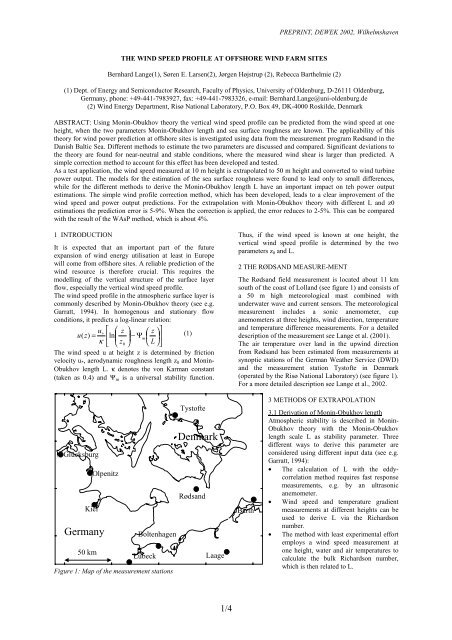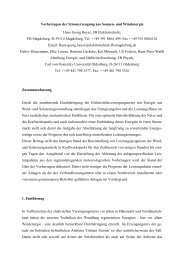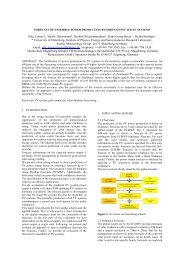Denmark Germany - CiteSeerX
Denmark Germany - CiteSeerX
Denmark Germany - CiteSeerX
You also want an ePaper? Increase the reach of your titles
YUMPU automatically turns print PDFs into web optimized ePapers that Google loves.
THE WIND SPEED PROFILE AT OFFSHORE WIND FARM SITES<br />
1/4<br />
PREPRINT, DEWEK 2002, Wilhelmshaven<br />
Bernhard Lange(1), Søren E. Larsen(2), Jørgen Højstrup (2), Rebecca Barthelmie (2)<br />
(1) Dept. of Energy and Semiconductor Research, Faculty of Physics, University of Oldenburg, D-26111 Oldenburg,<br />
<strong>Germany</strong>, phone: +49-441-7983927, fax: +49-441-7983326, e-mail: Bernhard.Lange@uni-oldenburg.de<br />
(2) Wind Energy Department, Risø National Laboratory, P.O. Box 49, DK-4000 Roskilde, <strong>Denmark</strong><br />
ABSTRACT: Using Monin-Obukhov theory the vertical wind speed profile can be predicted from the wind speed at one<br />
height, when the two parameters Monin-Obukhov length and sea surface roughness are known. The applicability of this<br />
theory for wind power prediction at offshore sites is investigated using data from the measurement program Rødsand in the<br />
Danish Baltic Sea. Different methods to estimate the two parameters are discussed and compared. Significant deviations to<br />
the theory are found for near-neutral and stable conditions, where the measured wind shear is larger than predicted. A<br />
simple correction method to account for this effect has been developed and tested.<br />
As a test application, the wind speed measured at 10 m height is extrapolated to 50 m height and converted to wind turbine<br />
power output. The models for the estimation of the sea surface roughness were found to lead only to small differences,<br />
while for the different methods to derive the Monin-Obukhov length L have an important impact on teh power output<br />
estimations. The simple wind profile correction method, which has been developed, leads to a clear improvement of the<br />
wind speed and power output predictions. For the extrapolation with Monin-Obukhov theory with different L and z0<br />
estimations the prediction error is 5-9%. When the correction is applied, the error reduces to 2-5%. This can be compared<br />
with the result of the WAsP method, which is about 4%.<br />
1 INTRODUCTION<br />
It is expected that an important part of the future<br />
expansion of wind energy utilisation at least in Europe<br />
will come from offshore sites. A reliable prediction of the<br />
wind resource is therefore crucial. This requires the<br />
modelling of the vertical structure of the surface layer<br />
flow, especially the vertical wind speed profile.<br />
The wind speed profile in the atmospheric surface layer is<br />
commonly described by Monin-Obukhov theory (see e.g.<br />
Garratt, 1994). In homogenous and stationary flow<br />
conditions, it predicts a log-linear relation:<br />
⎡ ⎛ ⎞ ⎛ ⎞⎤<br />
= ⎢ ⎜<br />
⎟ − Ψ ⎜ ⎟⎥<br />
⎣ ⎝ ⎠ ⎝ ⎠⎦<br />
∗ u z z<br />
u( z)<br />
ln<br />
(1)<br />
m<br />
κ z0<br />
L<br />
The wind speed u at height z is determined by friction<br />
velocity u *, aerodynamic roughness length z0 and Monin-<br />
Obukhov length L. κ denotes the von Karman constant<br />
(taken as 0.4) and Ψm is a universal stability function.<br />
Glücksburg<br />
Kiel<br />
<strong>Germany</strong><br />
50 km<br />
Olpenitz<br />
Boltenhagen<br />
Lübeck<br />
Figure 1: Map of the measurement stations<br />
Tystofte<br />
<strong>Denmark</strong><br />
Rødsand<br />
Laage<br />
Thus, if the wind speed is known at one height, the<br />
vertical wind speed profile is determined by the two<br />
parameters z 0 and L.<br />
2 THE RØDSAND MEASURE-MENT<br />
The Rødsand field measurement is located about 11 km<br />
south of the coast of Lolland (see figure 1) and consists of<br />
a 50 m high meteorological mast combined with<br />
underwater wave and current sensors. The meteorological<br />
measurement includes a sonic anemometer, cup<br />
anemometers at three heights, wind direction, temperature<br />
and temperature difference measurements. For a detailed<br />
description of the measurement see Lange et al. (2001).<br />
The air temperature over land in the upwind direction<br />
from Rødsand has been estimated from measurements at<br />
synoptic stations of the German Weather Service (DWD)<br />
and the measurement station Tystofte in <strong>Denmark</strong><br />
(operated by the Risø National Laboratory) (see figure 1).<br />
For a more detailed description see Lange et al., 2002.<br />
Barth<br />
3 METHODS OF EXTRAPOLATION<br />
3.1 Derivation of Monin-Obukhov length<br />
Atmospheric stability is described in Monin-<br />
Obukhov theory with the Monin-Obukhov<br />
length scale L as stability parameter. Three<br />
different ways to derive this parameter are<br />
considered using different input data (see e.g.<br />
Garratt, 1994):<br />
• The calculation of L with the eddycorrelation<br />
method requires fast response<br />
measurements, e.g. by an ultrasonic<br />
anemometer.<br />
• Wind speed and temperature gradient<br />
measurements at different heights can be<br />
used to derive L via the Richardson<br />
number.<br />
• The method with least experimental effort<br />
employs a wind speed measurement at<br />
one height, water and air temperatures to<br />
calculate the bulk Richardson number,<br />
which is then related to L.
3.2 Sea surface roughness<br />
Compared to land surfaces the surface roughness of water<br />
is very low. Additionally, it is not constant with wind<br />
speed like for land surfaces, but depends on the wave<br />
field, which in turn is determined by the wind speed, fetch<br />
(distance to coast), etc. It is investigated how different<br />
models to describe the sea surface roughness influence the<br />
prediction of the wind profile. Four models for sea surface<br />
roughness z 0 are considered:<br />
• The simplest ’model’ is the assumption of a constant<br />
roughness, which is e.g. used in the WAsP program<br />
(z 0=0.2 mm) (Mortensen et al., 1993).<br />
• Most commonly used is the Charnock model<br />
(Charnock, 1955), which only depends on friction<br />
velocity.<br />
• Numerous attempts have been made to improve this<br />
description by including more information about the<br />
wave field, e.g. by including wave age (Johnson et<br />
al. 1998) as additional parameters.<br />
• These additional parameters require wave<br />
measurements, which are often not available for<br />
wind power applications. A fetch dependent model<br />
has therefore been developed, where the wave age<br />
has been replaced by utilising an empirical relation<br />
between wave age and fetch (Lange et al., 2001a).<br />
3.3 Comparison with Rødsand measurements<br />
From Monin-Obukhov theory (see eq.(1)) the wind speed<br />
at 50 m height is calculated from the measured 10 m<br />
wind. A deviation ∆ is defined as the ratio between this<br />
predicted and the measured wind speed. This deviation ∆<br />
has been computed for the Rødsand data for all<br />
combinations of the three models to derive the Monin-<br />
Obukhov length L and the four models for the sea surface<br />
roughness.<br />
Systematic deviations are always found for stable<br />
stratification. As example, the deviation ∆ for the gradient<br />
method to derive L is shown in figure 2 with the<br />
Charnock relation used to model z 0. A good agreement is<br />
found in the unstable region (10/L
conduction between land and water the air over land will<br />
often be warmer than the sea surface temperature. The<br />
flow regime that develops in this situation has been<br />
described by several authors. We follow the explanation<br />
given by Csanady (1974):<br />
When warm air is blown over the cold sea, immediately a<br />
stable stratification develops as the air adjacent to the sea<br />
surface will be cooled. Simultaneously an internal<br />
boundary layer develops at the shoreline due to the<br />
roughness and heat flux change. In the case of warm air<br />
advection over cold sea this is a stable internal boundary<br />
layer (SIBL), characterised by low turbulence and<br />
therefore small fluxes and slow growth. The warm air is<br />
cooled from below while the sea surface temperature will<br />
remain almost constant in this process due to the large<br />
heat capacity of water. Eventually, the air close to the sea<br />
surface will have the same temperature as the water and<br />
atmospheric stability will be close to neutral at low<br />
heights. Above the internal boundary layer the air still has<br />
the temperature of the air over land and near the top of the<br />
SIBL an inversion lid has developed with strongly stable<br />
stratification separating these two regions. Thus, while the<br />
stability in the mixed layer is close to neutral, the elevated<br />
stable layer influences the wind speed profile and leads to<br />
a larger wind speed gradient than expected for an ordinary<br />
near neutral condition.<br />
Due to the small fluxes through the inversion lid this flow<br />
regime is a quasi-equilibrium state and can survive for<br />
large distances before eventually the heat flow through the<br />
inversion evens out the difference in potential<br />
temperatures. Eventually the neutral boundary layer is<br />
recovered, which is known from open ocean observations<br />
(Edson and Fairall, 1998).<br />
4.2 Prediction of the inversion height<br />
Csanady (1974) proposes the following expression for the<br />
depth of the mixed layer h in equilibrium conditions:<br />
1 ρ 2<br />
h = A u (2)<br />
∗<br />
g ∆ρ<br />
He estimates the empirical parameter A to 500. Here g is<br />
the gravitational acceleration, ρ the air density, ∆ρ the air<br />
density difference between surface and geostrophic level<br />
u50 meas /u50 pred, Bulk, Charnock<br />
1.40<br />
1.35<br />
1.30<br />
1.25<br />
1.20<br />
1.15<br />
1.10<br />
1.05<br />
1.00<br />
0.95<br />
0.90<br />
10 100 1000 10000<br />
h [m]<br />
Figure 5: Deviation ∆ bin averaged for the estimated<br />
height of inversion layer h (from eq. (2))<br />
3/4<br />
PREPRINT, DEWEK 2002, Wilhelmshaven<br />
at constant pressure and u * the friction velocity. For the<br />
Rødsand measurement the air density at geostrophic level<br />
has been estimated from the measured data at the Rødsand<br />
mast and at the surrounding land stations (see Lange et<br />
al., 2002).<br />
The bin averaged deviation ∆ for situations with long<br />
fetch (>30 km) is shown versus the inversion height h in<br />
Figure 5. The bulk method has been used to determine L<br />
and the Charnock equation for the estimation of z 0. Large<br />
deviations occur for low inversion heights of below 100<br />
m, decreasing rapidly with increasing inversion height<br />
and reaching a constant level at an inversion height of<br />
about 1000 m. This is in accord with the picture that an<br />
inversion height in the order of the boundary layer height<br />
will not lead to changes in the profile.<br />
4.3 Development of a simple correction method<br />
A micrometeorological model to take into account these<br />
effects is not available. Therefore a simple ad hoc<br />
correction method is developed here to investigate the<br />
importance of this effect for wind resource estimations. In<br />
Figure 6 it is shown that the deviation decreases with<br />
increasing height of the inversion layer. It is assumed that<br />
the deviation increases linearly with height. The simplest<br />
correction method is therefore to add a linear correction<br />
term to the wind speed profile of Monin-Obukhov theory<br />
(see eq. 1), which is proportional to the measurement<br />
height z and inversely proportional to the estimated<br />
inversion height h:<br />
⎡ ⎛ ⎞ ⎛ ⎞ ⎤<br />
= ⎢ ⎜<br />
⎟ − Ψ ⎜ ⎟ + ⎥<br />
⎣ ⎝ ⎠ ⎝ ⎠ ⎦<br />
∗ u z z z (3)<br />
u( z)<br />
ln<br />
m c<br />
κ z0<br />
L h<br />
From the Rødsand measurements the correction factor c is<br />
estimated to be about 4.<br />
The effect of this correction on the deviation ∆ is shown<br />
in Figure 6, where ∆ is bin averaged with respect to the<br />
stability parameter 10/L for different methods to derive L.<br />
This can be compared to figure 3, where the same is<br />
shown without correction. It can be seen that the<br />
deviations on the stable side are reduced considerably for<br />
all three methods.<br />
u50 meas /u50 pred<br />
1.20<br />
1.15<br />
1.10<br />
1.05<br />
1.00<br />
Sonic<br />
Gradient<br />
Bulk<br />
0.95<br />
-0.3 -0.2 -0.1 0.0 0.1<br />
10/L<br />
Figure 6: Bin-averaged ratio of measured and predicted<br />
50 m wind speed versus stability parameter 10/L with L<br />
determined by the sonic, gradient and bulk methods and<br />
z 0 with Charnock model; the proposed correction method<br />
for thermal influences is used
Prediction error [%]<br />
-10<br />
-8<br />
-6<br />
-4<br />
-2<br />
0<br />
WAsP<br />
M-O-theory<br />
M-O-theory with correction<br />
Constant<br />
Charnock<br />
Gradient<br />
5 PREDICTIONS OF POWER PRODUCTION<br />
In the context of wind energy utilisation it is important to<br />
know, which impact these different approaches have for<br />
the prediction of the power output of an offshore wind<br />
turbine. This is investigated in an example application:<br />
The power production of an example wind turbine with<br />
hub height 50 m and 1 MW rated power output is<br />
estimated from the wind speed measurement at 10 m<br />
height using the different methods and models described<br />
in the previous sections. The estimated production is than<br />
compared with that obtained by using the measured wind<br />
speed at 50 m height. For this test a 2 year long time<br />
series from Rødsand has been used, where only part of the<br />
measurements are available. Therefore the sonic method<br />
to derive L and the wave age model for z0 could not be<br />
compared.<br />
In Figure 7 the power output prediction error, defined as<br />
(Ppred –Pmeas)/Pmeas, is shown for all extrapolation methods.<br />
The estimated production with wind speed extrapolation<br />
is lower than that using the measured wind speed at hub<br />
height in all cases with errors ranging from 2% to 9%. For<br />
the gradient method to derive L, prediction errors of 7-9%<br />
are found. For the bulk method these are about 6-7%. For<br />
the different sea surface roughness methods it can be seen<br />
that the constant roughness assumption and the Charnock<br />
relation lead to almost equal results. The fetch model<br />
shows a slightly (about 1%) larger error. Using the<br />
correction method for the profile, the errors are reduced<br />
by about 4%. The results are also compared with the error<br />
of the WAsP method, which is about 4%.<br />
6 CONCLUSION<br />
Wind resource estimation at offshore sites is more<br />
complex than often believed. Not only the variable sea<br />
surface roughness, the determination of the atmospheric<br />
stability and the growth of the internal boundary layer<br />
complicate the situation, but also the land-sea<br />
discontinuity can lead to a special flow situation far<br />
offshore. In this flow regime the wind speed increases<br />
more rapidly with height than predicted by Monin-<br />
Constant<br />
Bulk<br />
Figure 7: Error in power output prediction (Pmeas-<br />
Ppred)/Pmeas of an example turbine for the 2 year long<br />
Rødsand data set; different methods to extrapolate the<br />
wind speed measurement at 10 m height to 50 m are used<br />
(see text); the result with the WAsP method is also shown<br />
Fetch<br />
Charnock<br />
Fetch<br />
4/4<br />
PREPRINT, DEWEK 2002, Wilhelmshaven<br />
Obukhov theory. It should be noted that these deviations,<br />
although caused by the coastal discontinuity, where found<br />
far offshore for fetches of 30 to 100 km.<br />
Currently these conclusions can be drawn for the site<br />
Rødsand only and need to be validated with other<br />
measurements. But from this example it can be seen that<br />
the flow modification in conditions of warm air advection<br />
from land plays an important role in the flow regime at<br />
offshore sites. At Rødsand this is the dominating<br />
uncertainty in the description of the wind conditions. We<br />
expect that a better understanding of this effect is a<br />
prerequisite for future improvements in the description of<br />
the wind regime over the coastal zone.<br />
To improve the wind resource estimation for offshore<br />
sites, a model for the flow regime in conditions of warm<br />
air advection from land over sea is needed. The simple<br />
correction method introduced in this paper is intended to<br />
show the importance of the effect, but can not be used as a<br />
general model of the flow regime. Further development<br />
with data from additional sites is needed. Until such a<br />
model is available, measurements at or close to hub height<br />
are necessary for an accurate estimation of the wind<br />
resource of an offshore location.<br />
ACKNOWLEDGEMENT<br />
The Rødsand measurement program was funded by:<br />
JOULE program of the EU (JOU2-CT93-0325), Office of<br />
naval research (N00014-93-1-0360), Danish Energistyrelsen<br />
(UVE J.nr. 51171/96-0040) and ELKRAFT. The<br />
technical support team at Risø and Sydfalster-El are<br />
acknowledged for their contribution to the data collection.<br />
REFERENCES<br />
Charnock, H, 1955: Wind stress over a water surface.<br />
Quart. J. Roy. Meteor. Soc, 81, 639-640.<br />
Csanady GT, 1974: Equilibrium theory of the<br />
planetary boundary layer with an inversion lid. Boundary-<br />
Layer Meteorol., 6, 63-79.<br />
Edson JB. Fairall CW, 1998: Similarity relationships<br />
in the marine atmospheric surface layer for terms in the<br />
TKE and scalar variance budgets. J. Atmos. Sci., 55,<br />
2311-2328.<br />
Garratt JR, 1994: The atmospheric boundary layer.<br />
Cambridge, Cambridge University Press.<br />
Johnson HK, Højstrup J, Vested HJ, Larsen SE, 1998:<br />
On the Dependence of Sea Surface Roughness on Wind<br />
Waves. J. Phys. Oceanogr.. 28, 1702-1716.<br />
Lange B, Barthelmie RJ and Højstrup J, 2001:<br />
Description of the Rødsand field measurement. Report<br />
Risø-R-1268. Risø National Laboratory, DK-4000<br />
Roskilde, <strong>Denmark</strong>.<br />
Lange B., Højstrup J, Larsen SE, Barthelmie RJ,<br />
2001a: A fetch dependent model of sea surface roughness<br />
for offshore wind power utilisation. European Wind<br />
Energy Conference, Copenhagen, <strong>Denmark</strong>.<br />
Lange B, Larsen S, Højstrup J, Barthelmie R, 2002:<br />
The influence of thermal effects on the wind speed profile<br />
of the coastal marine boundary layer. submitted to<br />
Boundary-Layer Meteorol.<br />
Mortensen NG, Landberg L, Troen I, Petersen EL,<br />
1993: Wind Analysis and Application Program (WASP),<br />
User’s Guide. Risoe-I-666(EN) (v.2), Risø National<br />
Laboratory, <strong>Denmark</strong>; 133 pp.








